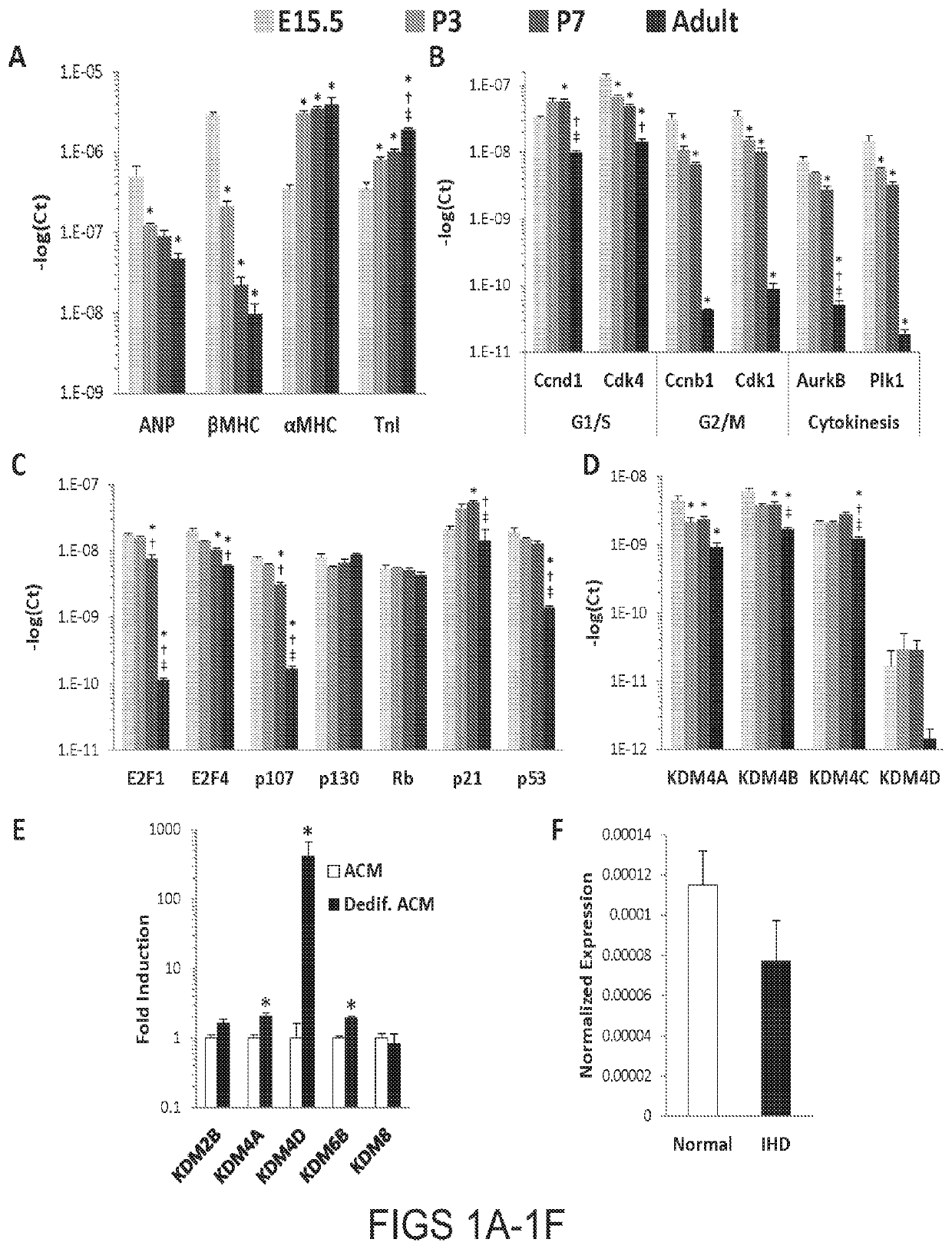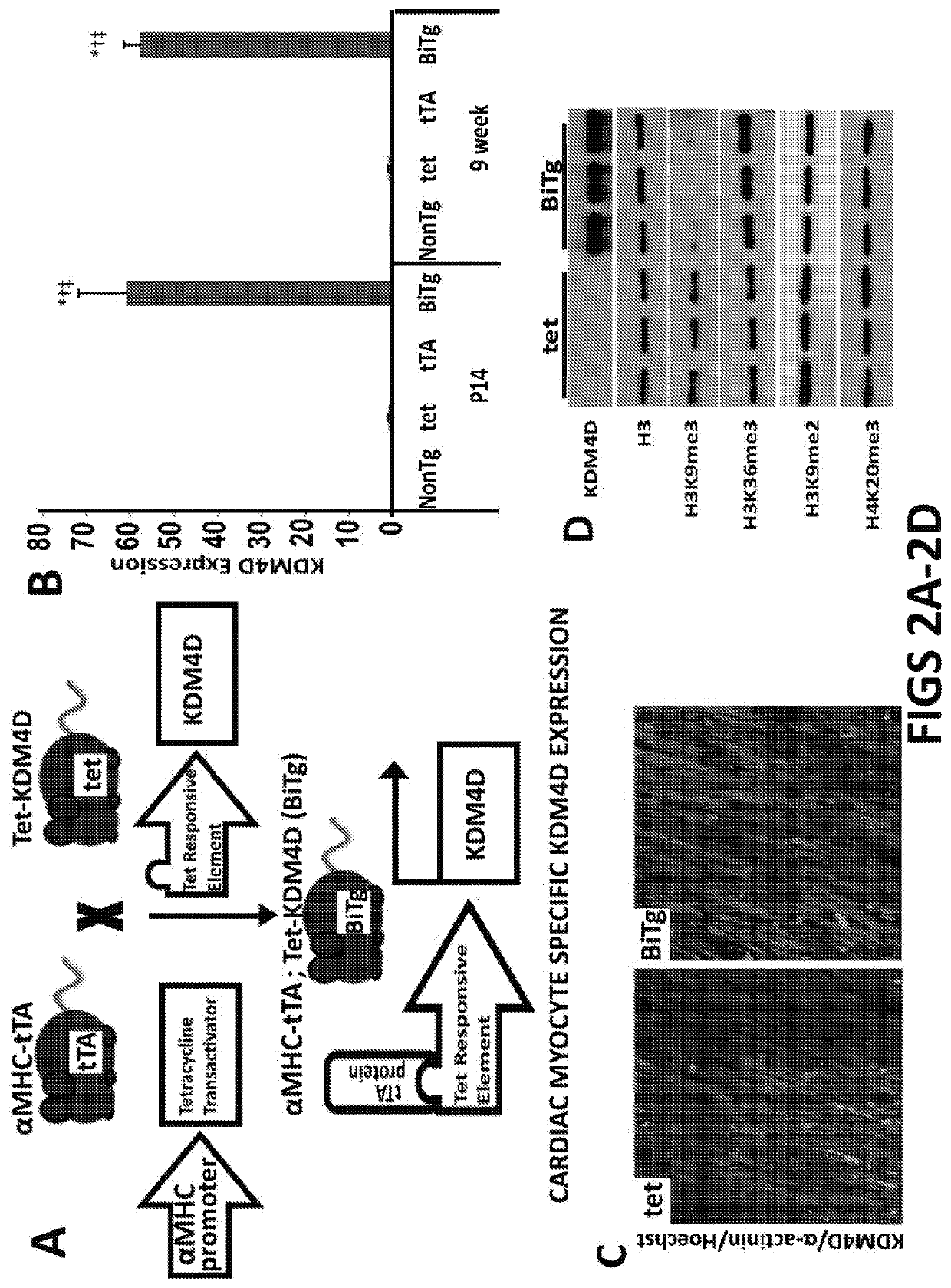Vectors and methods for regenerative therapy
a vector and regenerative therapy technology, applied in the field of vectors and regenerative therapy, can solve the problems of limited source of new acms and loss of regenerative capacity of mammalian hearts
- Summary
- Abstract
- Description
- Claims
- Application Information
AI Technical Summary
Problems solved by technology
Method used
Image
Examples
example 1
Epigenetic Regulation of Cardiac Myocyte Cell Cycle Arrest
[0071]This example demonstrates that trimethylation of Lysine 9 of Histone H3 (H3K9me3), a histone modification associated with heterochromatin, is required for the silencing of cell cycle genes in adult CMs (ACMs). To test this, we developed a transgenic (BiTg) mouse model where H3K9me3 is specifically removed by histone demethylase KDM4D in CMs. Loss of H3K9me3 in CMs disrupts ACM cell cycle gene silencing preferentially and results in increased CM cycling. Normalized heart mass was increased by postnatal day 14 (P14) and continued to increase until 9-weeks of age. ACM number, but not size, was significantly increased in BiTg hearts, suggesting CM hyperplasia accounts for the increased heart mass. Challenging H3K9me3-depleted hearts with a hypertrophic growth signal stimulated ACM mitotic activity. Thus, we demonstrated that H3K9me3 is required for cell cycle gene silencing in ACMs and depletion of H3K9me3 allows hyperplast...
example 2
Neonatal Mouse Regeneration Model
[0110]An animal model for regeneration of heart tissue is illustrated in FIG. 16. Using this model, mice overexpressing KDM4D show enhanced regeneration after myocardial infarct (MI) per histological analysis, as illustrated in FIG. 17. A statistically significant (p<0.05) reduction in both average fibrotic area and maximum fibrotic area was observed in KDM4D overexpressing mice compared to control mice at 21 days after MI. These data demonstrate the utility of KDM4D for regenerative therapy of cardiac tissues.
example 3
Gene Therapy for Heart Regeneration
[0111]Vectors can be constructed for implementation and assessment of cardiac regeneration using gene therapy. The vectors can be constructed using AAV viruses, such as AAV6 or AAV9 or other hybrid AAV serotypes offering specificity for cardiac myocytes. A Troponin promoter is used for CM-specific expression. The AAV-KDM4D vector (expressing SEQ ID NO: 1 and optionally SEQ ID NO: 2) is injected into cardiac tissue at, or shortly after, the time of myocardial infarct. Assessment of heart function by echocardiography (ECHO) and cardiac magnetic resonance (CMR) is performed at subsequent time intervals to monitor recovery and regeneration. At the conclusion of the study, infarct size and ACM proliferation are assessed.
[0112]In one version of the construct, KDM4D can be shut off after a few weeks of regeneration to return KDM4D levels back to baseline, once lost CMs have been repopulated. Those skilled in the art will appreciate adjustments to the prot...
PUM
 Login to View More
Login to View More Abstract
Description
Claims
Application Information
 Login to View More
Login to View More - R&D
- Intellectual Property
- Life Sciences
- Materials
- Tech Scout
- Unparalleled Data Quality
- Higher Quality Content
- 60% Fewer Hallucinations
Browse by: Latest US Patents, China's latest patents, Technical Efficacy Thesaurus, Application Domain, Technology Topic, Popular Technical Reports.
© 2025 PatSnap. All rights reserved.Legal|Privacy policy|Modern Slavery Act Transparency Statement|Sitemap|About US| Contact US: help@patsnap.com



